Alumni Stories
2020s Alumni

Devon Blankenbaker
Devon was a Mellon LACE fellow and earned a BA in art history from the University of Virginia at Charlottesville in addition to attending the Brooks Institute to study photography. Before starting his graduate studies, he was an assistant exhibition coordinator and a conservation intern at the Albert and Shirley Small Special Collections Library at the University of Virginia. While at the University of Virginia, Devon was also both a collections management and exhibition intern at the Kluge-Ruhe Aboriginal Art Collection which features one of the best indigenous Australian art collections in the world. During the summer of 2023, he was an intern in book conservation at Emory University's Woodruff Library in Atlanta and has been active in the department's Equity & Inclusion Committee. Devon completed a third-year book conservation internship at the Library of Congress in Washington, D.C and is now the Conservator for Special Collections at Cornell University.

Elise Cabral
Elise is originally from San Diego where she was a pre-program Mellon Fellow in Paper Conservation at the Balboa Art Conservation Center. She earned an MA in modern and contemporary art history, theory, and criticism from the School of the Art Institute of Chicago. Elise was also an advanced book conservation intern and summer lab manager at the Buffalo Bill Center of the West in Cody, WY and spent the summer of 2023 interning in paper and photograph conservation at the Amon Carter Museum in Fort Worth, TX. Elise was a third-year intern at the Library of Congress in Washington, D.C. and post-graduation, she is now a Research Conservator there, working on creating guidelines for treatment with citrates. Starting in 2026, she will be a Temporary Associate Book/Paper Conservator at the Baltimore Museum of Art.

Sophie Church
Sophie came to Buffalo from Arizona where she was a conservation assistant at both the Center for Creative Photography in Tucson, and the Arizona State Library, Archives, and Public Records in Phoenix. She attended the University of Arizona in Tucson earning an MA in art history. While at the U of A, she was the objects conservation intern at the Arizona State Museum and a student assistant in the University Libraries and Special Collections. Sophie also earned a BA in comparative cultural studies from Northern Arizona University in Flagstaff and spent the summer of 2023 as a photograph conservation intern at the Harry Ransom Center in Austin, TX. She is currently a third-year intern at the Library of Congress in Washington, D.C., studying photograph conservation where she is continuing as the postgraduate Harper-Inglis Fellow in Photograph Conservation as of this fall.

Vu Do
Vu is a Fulbright Vietnamese Student Scholar and was an associate lecturer at Vietnam National University teaching Art and Design Materials for Business Management before coming to Buffalo. He has a BFA in paintings from the Pennsylvania Academy of the Fine Arts in Philadelphia where his work was exhibited in several student shows. Vu is an accomplished artist and lecturer who has taught at both The Painter’s Studio and Wellspring Hanoi International Bilingual School in Vietnam. He hopes to return to Vietnam after his graduate studies to promote the conservation of cultural relics. Vu recently completed a graduate summer internship at the Smithsonian National Museum of Asian Art and also attended the 7th Forbes Symposium on Scientific Research in the Field of Asian Art hosted by the museum in 2023. He completed a third-year internship at the National Gallery of Art in the objects conservation lab. After graduation, Vu will return to Vietnam to complete the Fulbright program and in October 2025, he will return to the Smithsonian National Museum of Asian Art as the Gretchen and David Welch Fellow.

Renata Gumkowska
Renata earned a BA in art history and studio art from Hunter College in New York, NY in addition to studying life drawing at The Arts Students League of New York. While in the city, she was a pre-program intern at the American Museum of Natural History in the Anthropology Department and a collections assistant at the American Folk Art Museum. Renata was also a conservation assistant at Luca Bonetti, Corp., a private conservation practice in New York and a summer intern at Aurora Art Conservation in Grand Island, NY. She completed a third-year internship in paintings conservation at the Cleveland Museum of Art and is now at the Philadelphia Museum of Art for a two-year-long Andrew W. Mellon Fellowship in Paintings Conservation.

Sutton Hastman
Sutton completed a third-year internship at the National Park Service in Harper's Ferry, WV in the objects conservation lab. Before starting her graduate studies, she was an art conservation technician for several years with Richmond Conservation Studio in Virginia where she gained experience in paintings, objects, and paper conservation treatments. Sutton earned both a BS in chemistry and a BA in art history from Mary Baldwin College (now University) in Staunton, VA where she won The Ulysse Desportes Award for Outstanding Achievement in Art History. She was also a custom framer at Michael’s in the fine arts department and spent a summer interning at the Cleveland Museum of Art in the objects conservation lab. Sutton is currently a contract conservator in West Virginia.

Charlotte Starnes
Charlotte was a Mellon LACE fellow and earned a BA in art history from Florida State University in Tallahassee, FL in addition to a second BA in international relations and global affairs from Eckerd College in Saint Petersburg, FL. While attending Eckerd College, she studied abroad in Honduras, Malta, Ghana, and England. Before starting her graduate studies, Charlotte was an archaeological conservation laboratory intern at the Florida Bureau of Archaeological Research Conservation Lab in addition to holding positions at both the Florida State University Special Collections and the Georgia State Archives in Morrow. In 2023, she had a busy summer attending Rare Book School in London and interning at the American Philosophical Society in Philadelphia. Charlotte completed a third-year internship at the Folger Shakespeare Library in Washington, D.C. in the book conservation lab.

Sara Thornburg
Before starting her graduate studies, Sara had three conservation internships at the Harpers Ferry Center, Museum Conservation Services division of the National Park Service in Charles Town, WV. She was also a custom framer at Michael’s Stores where she worked on fragile pieces along with doing mats and preservation design. Sara is an accomplished illustrator and attended the Columbus College of Art and Design, where she earned a BFA in illustration in addition to attending an AIC Preventive Conservation Workshop at the Staatsburgh State Historic Site in NY. During the summer of 2023, she interned at Spicer Art Conservation in Delmar, NY where she focused on textile conservation, treating a flag from the women’s suffrage movement. Sara was a third-year intern at Colonial Williamsburg in Virginia in the textile conservation lab where she is be continuing after graduation as the Marshall Steel Post Graduate Fellow in Textile Conservation.

Madison Whitesell
Madison attended James Madison University (JMU) in Harrisonburg, VA where she earned a BA in studio art and art history with a concentration in museum studies. While at JMU, she held positions at the Duke Hall Gallery of Fine Arts, the Visual Resources Center, and the preservation and special collections department of the Carrier Library. Madison was also a conservation technician at The Walters Art Museum in Baltimore, MD and a studio assistant at Brydgeworks Glass Studio in Harrisonburg, VA where she taught stained glass workshops. During the summer of 2023, she completed a graduate summer internship in textiles conservation at the Museum of Fine Arts, Boston. Madison is spent her third year of graduate studies interning at the Smithsonian American Art Museum in the objects conservation lab and is currently the Jenrette Fellow at Historic New England in Haverhill, MA.

Grace Wilkins
Before beginning her graduate studies at Buffalo State, Grace graduated in 2020 with a bachelor's degree in neuroscience from Brown University. She was a pre-program intern at both the Brooklyn Museum and Gawain Weaver Art Conservation, a private practice photograph conservation firm in California. Grace worked as a graduate intern at the Carnegie Museum of Art in Pittsburgh, Pennsylvania in the summer of 2023, and at Glenstone in Potomac, Maryland in the summer of 2024. Grace spent her third year as a graduate intern in the Decorative Arts and Sculpture Conservation Department at the J. Paul Getty Museum in Los Angeles, California. After receiving her graduate degree, Grace is currently the Engen Conservation Fellow at the Smithsonian National Air and Space Museum.
1980s-1990s Alumni
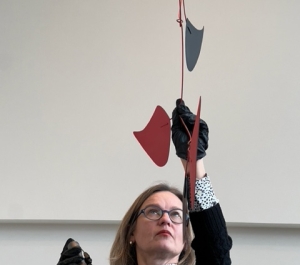
Abigail Mack, '94
Abigail Mack holds a Bachelors Degree in Fine Arts from The School of the Art Institute of Chicago, a Masters Degree in Art Conservation from the State University College of New York at Buffalo and has continued her education in Coatings and Polymeric Science at North Dakota State University. Half of her professional career has been as a conservator in museums, notably the Brooklyn Museum of Art and the National Gallery of Art, and the other half in private practice. In addition to her private practice, Abigail is also part owner of Monumenta Art Conservation & Finishing, LLC which focuses on the conservation and maintenance of large-scale and monumental artworks. Currently Abigail is a Professional Associate of AIC, acts as a Field Conservator for the Outdoor Painted Sculpture Project, and co-teaches a GCI workshop on the same. She also serves on the Board of Advisors for the Calder Foundation, is an Advisor to the Louise Nevelson Foundation, is a consulting conservator for the Tony Smith Estate, and Morgan Art Foundation for Robert Indiana. The main thrust of her work is modern and contemporary artworks with specific experience and research on painted outdoor sculpture. To this end, Abigail is actively involved in developing, more durable, alternative paints in collaboration with artists and artists’ estates.
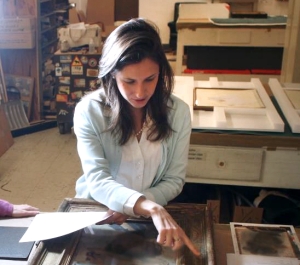
Ana Alba '09
Ana Alba is the owner and chief conservator of Alba Art Conservation, a private conservation practice established in 2014. Ana earned her Masters and a Certificate of Advanced Study in Art Conservation in 2009 with a specialty in painting conservation from the Garman Art Conservation Department at Buffalo State and received her Bachelor of Fine Arts degree in Art History from the University of Florida.
Her clients include The National Gallery of Art, the Smithsonian American Art Museum, Washington and Jefferson College, Soldiers and Sailors Memorial Hall and Museum, The Philadelphia Museum of Art, and The Georgia O'Keeffe Museum. Ana previously interned at both the Hirshhorn Museum and Sculpture Garden and the Wadsworth Atheneum in addition to receiving the William R. Leisher Fellowship for the Conservation of Modern and Contemporary Paintings at the National Gallery of Art, Washington, D.C.
Ana was recently featured on the National Gallery of Art's website for her work treating Jean Dubuffet's "Façades d’Immeubles (Building Façades)," from 1946.
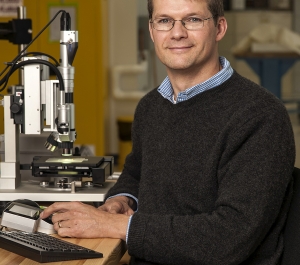
Malcolm Collum, '95
Like many children growing up in the 1970s, Malcolm Collum, a ’95 graduate of Buffalo State’s art conservation program, eagerly awaited reruns of the original Star Trek TV series, the cult classic that ran from 1966 to 1969 and introduced multiple generations to the adventures of Captain Kirk (William Shatner) and Mr. Spock (Leonard Nimoy) and their crew aboard the USS Enterprise.
What 48-year-old Collum didn’t know as a child was that one day he would have the opportunity to oversee conservation of the iconic starship that captured so many imaginations. In his job as chief conservator and Engen Chair of Conservation for the Smithsonian’s National Air and Space Museum, Collum has been charged with bringing the 11-foot USS Enterprise studio model, which Paramount Studios gave to the museum in 1974, back to its former glory.
“I know I’ve been handed a huge responsibility,” said Collum, who has worked at the museum since 2008. Previously, he served as senior conservator at the Henry Ford Museum.
For the past 15 years, the starship has been on a centerpiece display in the museum’s gift shop, protected in a glass case. Now the museum is preparing for the Boeing “Milestones of Flight” exhibit that will open in 2016. And it’s fitting that the starship, one of several iconic artifacts included in the exhibition, will be given new life during the 50th anniversary of the original Star Trek series.
First, the starship needs conservation treatment. The Enterprise is now in a Smithsonian lab where Collum, in concert with curator Margaret Weitekamp, is embarking on a year-long project, which began with an assessment of its condition. He even borrowed an x-ray machine from the National Zoo to see inside.
“Disassembling any one-of-a-kind object is fraught with uncertainty,” he said. “The radiographs let us know where every nail and screw is located before we attempt to remove components. In some cases it provides enough information to negate the need to remove a part. It also illustrates some of the work that was done during previous restorations and reveals the internal construction. Basically, there are no surprises once we begin work.”
On the exterior, he has found definite evidence of the starship model’s age.
“The paint is starting to flake. There are cracks and some lines where there shouldn’t be.”
The model also suffered damage from a move and a restoration in the early 1990s.
“They were a little heavy-handed with the airbrush paint, and the result upset some Star Trek fans,” he said. “We’re going to do touch-up work and bring the entire model back to the reference point (of the original). I want to make fans happy and get it back to a more true representation of what it was.”
Collum recently hired another Buffalo State Art Conservation graduate, Ariel O’Connor, ’09, to assist with the Enterprise project, along with other projects in the museum, and he plans to bring in an outside paint analysis specialist to help identify the model’s paint history, types, and sequences.
He noted that the art conservation program prepared him well for the monumental task ahead.
“Having the scientific background and the overall art conservation training at Buffalo State instilled in me the confidence to decipher what causes aircrafts to deteriorate and to use logic to find the most appropriate way to conserve them,” Collum said, adding, “I think Spock would approve.”
Learn more about the Enterprise project at trekcore.com.
Photos: Dane Penland, National Air and Space Museum
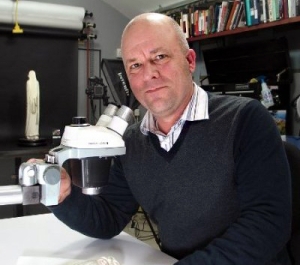
Robert Krueger, '09
After graduating in 2009, I returned to my hometown of Portland, Oregon to live with my wife, our two greyhounds, and our orange tabby cat in our little white bungalow. I promptly registered my business, Cascadia Art Conservation Center, LLC and began transforming the detached garage into my lab. In March, before the lab was completed, our son, Kalman, was born.
Prior to attending SUNY Buffalo, I worked as the collections manager for the arts council in Portland and in my free time created and showed my own artwork. My job at the arts council offered the introduction to the field of conservation and the need for conservators in the Northwest. When I left Portland for Buffalo, my goal after graduating was to return to Portland, start my own private conservation practice to work with public art collections, and help fill the conservation needs in the Northwest.
Since purchasing our home 6 years ago, the detached garage was my sculpture studio. After graduation I said good-bye to the studio and began converting it into a conservation lab built to current conservation lab standards. The garage was stripped down to the frame and re-built. The former detached garage is now an energy efficient climate controlled modern conservation lab with proper exhaust ventilation , 50,000 Kelvin lighting throughout and a view of our garden.
Though my budget was tight, my goals for the lab were lofty. To save money I did most of the work myself including researching equipment. The handouts on equipment from Dan Kushel’s class served as a valuable guide. I installed a split system ductless heat-pump, exhaust fan, plumbing, electrical, and a humidifier, and unlike Stephanie, I had a contractor do all the sheet-rocking. Most of the equipment was purchased online or second-hand. I built and installed custom cabinets and laminated the countertops with Formica. A year after launching Cascadia Art Conservation Center, business is picking up and getting in the way of putting the finishing details on minor things like cabinet doors, but the lab is now fully functional.
Having a connection to the local art scene through my past work with the arts council and as an artist was integral in making contacts when I began offering my services. Building an informative website has been a huge boost in getting the business going. To date, I’ve been so busy working that I have not yet had a chance to do much outreach. I have also continued a research project I began during my third year at the Nelson-Atkins Museum of Art in Kansas City, MO, on fountain maintenance. At the 2010 American Institute for Conservation (AIC) meeting in Milwaukee, I presented a paper on this subject.
I couldn’t have accomplished any of this if it wasn’t for the understanding and endless support from my wife Alyssa, the Professors and staff in the Conservation department, and Jonathan Thornton for not only being a great professor, but also helping me find a third year internship that was invaluable in working towards my goals.
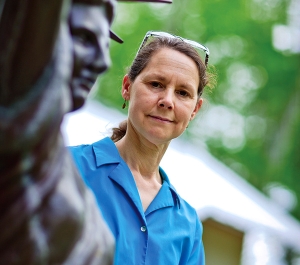
Marianne Russell Marti, '87
Marianne Russell Marti, ’87, is a rare breed. From the age of 12, she knew precisely what she wanted to do with her life: become an art conservator.
Inspired by a trip to the Saint Louis Art Museum, Marti was fascinated by the work being done at the museum’s art conservation studio. She loved making art as a child, but treating and cleaning artwork was a whole new world for her. “I really fell in love with it,” she said.
Today, Marti is living her dream as an art conservator with her own practice. After earning a B.A. in art history from Washington University in 1982 and an M.A. in art conservation from Buffalo State, she and her husband, Bob, who is also a conservator, established Russell-Marti Conservation Services in California, Missouri. They specialize in outdoor sculpture with a focus on bronze. “We very much enjoy working on outdoor public art,” she said, “because of the interaction with the local people and the sense of pride that is felt, or sometimes reestablished, through the attention and care given to a community’s public monuments.”
Marti’s work goes well beyond conserving artwork; it’s also about preserving history. In 1988, for instance, her firm was first commissioned to work on Abraham Lincoln’s tomb in Springfield, Illinois. Over the years, they’ve done maintenance work on the outside of the burial tomb and spent some time inside the tomb itself, cleaning the decorative bronze works. Ironically, they’ve done similar work in Chicago on the tomb of Stephen Douglas, Lincoln’s political opponent in the presidential election of 1860.
Several years later, Marti and her crew traveled to Pearl Harbor to work on the ship’s bell from the U.S.S. Arizona, which was sunk during the surprise attack in 1941 and is still submerged today. “At the time, there were some questions as to whether the bell had actually come from the Arizona,” she said. “But we discovered charred and burned material inside the bell, indicating that it had been on the boat during the attack.”
In May 2010, Marti’s career came full circle when she arrived back in Buffalo to conserve part of the Queen City’s history. During a three-month project overseen by the Buffalo Arts Commission, she and her crew restored 19 indoor and outdoor sculptures. Work included removing dirt and grime from a marble bust of Millard Fillmore in City Hall, reapplying a protective coating on the Young Lincoln in Delaware Park, and removing graffiti from the Indian Hunter, also in Delaware Park. The work that probably received the most attention involved the David sculpture along the Scajaquada Expressway. These restoration efforts included attaching the statue, which had previously been free-standing, to its pedestal.
Busy in her flourishing career, Marti points to her degree from Buffalo State as a great starting point. “Buffalo State offered a well-rounded education in art conservation,” she said. “And it helped me enormously right from the start. It’s such a respected program, and it opened a lot of doors for me. I still get a lot of ongoing support from the faculty. So it’s just been a wonderful resource.”
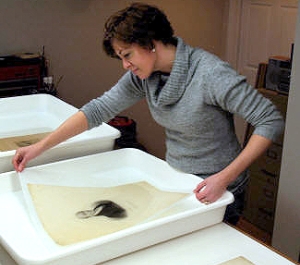
Laura Schell, '97
Laura Schell, '97, has worked as a paper conservator in private practice since 1999. She has treated a wide variety of paper-based objects ranging from western and Asian fine art, Old Master prints, large and small ephemera, historic objects such as wall maps, charts, blueprints, and significant documents. Her client list includes museums, non-profits, historical societies, upscale framers and private owners.

Gwen Spicer, '91
Gwen Spicer, '91, started Spicer Art Conservation, L.L.C. in 1995, caring for collections from museums, historical societies, state agencies, businesses, and private owners. Her focus is to distinguish long-term collection care and preservation of artifacts. Gwen Spicer is a trained object, textile and upholstery conservator.

